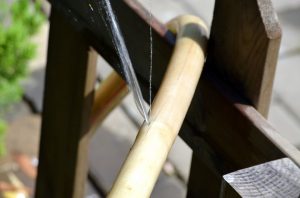In order to bill property owners the correct amount each month, the utility company will monitor the home or building’s water meter. However, when there is a leak, these costs can skyrocket, leaving you stuck with an expensive bill at the end of the month. It can also leave your home with severe water damage and even mold growth if it is left alone without treatment. To avoid these problems, it is essential to find and fix the leaks as soon as possible before becoming stuck with another hefty bill. Take these following steps to learn how to find a water leak:
Finding the Leak
 Monitor your water meter. The first step to finding water leak in your home is to make sure you have one (otherwise there may be someone who is using a significant amount of water without you knowing!). To do this, locate the water meter on your property as most residences have one.
Monitor your water meter. The first step to finding water leak in your home is to make sure you have one (otherwise there may be someone who is using a significant amount of water without you knowing!). To do this, locate the water meter on your property as most residences have one.
- Record the amount used before turning off all water lines throughout the home.
- Wait at least 2 hours without running the water.
- Check the meter again to see if the amount has increased. If so, you most likely have a leak; however, even if it has not, it doesn’t necessarily mean that you don’t. Read on to determine the location of the possible leak.
Water Leaks: Outside vs. Inside
Determining whether the leak is inside or outside can save you half the work and time in having the problem solved. Follow these steps:
- Locate and shut off the main water valve on the property. It is usually in the basement, garage behind an outdoor faucet, or outside below an outdoor faucet.
- Again, wait a few hours before reading the water meter again. If it has not moved, you have a water leak inside the house. If has moved, the leak is outside between the house and the meter.
Outside Leak
 If you have found that the leak is outside, take these steps to find the leak in the water line between the house and meter.
If you have found that the leak is outside, take these steps to find the leak in the water line between the house and meter.
- If the shutoff valve is outside of the house, turn it off and inspect the meter by taking off the lid and watching the dial.
- If you can’t find the meter head, you may have to dig around the meter as it can be covered by dirt and grass.
- When you see that it has not moved after not running the water, inspect the area of the line running from the house to the meter. If you see any muddy areas, patches of grass that are greener or it is growing faster than others, this is most likely the area of the leak. Determine if you can fix it yourself or to call a plumber.
If the leak is outside the house, also inspect these outdoor water components and areas:
The Garden. Especially during the summer time, gardening can be a relaxing and fun hobby. But when finding drastic increases in the water bill after watering your flowers, fruit, and vegetable plants, it’s not so fun after all. Be sure to check all taps, drip irrigation systems, and hoses for a possible water leak.
The Hose-Bibs. Hose-bib are the pipes that connect your hose to your main water line. To find if there is a leak in these areas, check the front and back of your home, as they are usually located in these areas.

- After finding them, use a long screwdriver to put the metal side directly on the metal part of the hose-bib while placing your thumb knuckle directly on top of the screwdriver. Then, put your ear to your thumb and listen carefully; the sound from the leak will travel directly into your eardrum. In this case, the screwdriver serves as a stethoscope for detecting a water leak.
- Be sure to pay close attention as to where the sound is coming from within the hose-bib. If you find that it is louder in one valve than the other, the leak is closer to the louder component. It would also be a good idea to mark the location where you can hear it the most. If you have a plumber fixing the leak, informing them of this can save you money because he or she won’t have to waste time finding the leak.
- In the case that you don’t find the leak with the hose-bibs and screwdriver, the source is most likely far from their locations.
The Swimming Pool. Although it is most helpful if the pool is drained, the leak is most often noticed when it is full of water. You may also notice the water level dropping if you do have a leak.

- Depending on how you want to find the source, you may have to dive in to find any cracks at the bottom or sides that are allowing water to seep through.
- You can also inspect around the pool to find any muddy areas, greener grass, or areas that it is growing faster than others.
Inside Leak
If you find that it is inside the house, inspect the interior components and areas for water leaks:

The Toilet. This can sound like a messy job, but it will be worth avoiding an expensive water bill in the future.
First, remove the lid of the tank and listen closely for any hissing noises; they are a key indicator of a leak. If so, find out where they are coming from and determine if you can fix it yourself. If not, you may have to call a plumber.
- If you do not hear any strange noise, add a few drops of food coloring in the tank. If you see it in the bowl, you have a leak in the flapper at the bottom of the tank. If you are not able to fix it yourself, go ahead and call a professional.
- Be sure to repeat this process for all toilets on the property. It is possible that you may have more than one leak.
- The Shower Head. This is one of the most common types of water leaks. Fixing this should be a simple home repair.
- The Hot Water Heater. When inspecting this area, be sure to be extremely careful as the water can be scalding hot within the tank itself. But if you notice a puddle of water around your hot water tank, it may be time to replace it. Also, be sure to check the Pressure Relief Valve as they can be connected directly to the drain. If you can’t remove the drain pipe, listen closely for a hissing sound, which is a key sign of a leak.
Other Leaks
If you have inspected all of these areas and sources for water leaks and still have not found anything, don’t be discouraged. These signs can easily be overlooked or hidden due to pipe placement, silent dripping, or location of the leak. It can also be possible that you may notice a sign in one area but the leak can be in a different area of the house due to the flow of water.
Finding the leak yourself can you save a ton of money in plumbing costs, but even finding an approximate location and signs for water leaks will help save some dollars.
Repairing the Damage
 If you are able to find the leak, you are already on the road to saving a fortune in plumbing repair costs. But if you are not able to fix it yourself, don’t hesitate to call a professional plumber. While it can be expensive, depending on the type, location, and size of the leak, it can prevent significant water damage to your building structure, such as warping, discoloration, and deterioration. It is also at risk for mold growth, creating even bigger problems.
If you are able to find the leak, you are already on the road to saving a fortune in plumbing repair costs. But if you are not able to fix it yourself, don’t hesitate to call a professional plumber. While it can be expensive, depending on the type, location, and size of the leak, it can prevent significant water damage to your building structure, such as warping, discoloration, and deterioration. It is also at risk for mold growth, creating even bigger problems.
If you have found the leak has already caused water damage to your building materials, such as the ceiling, floors, drywall, carpet, etc., do not hesitate to call a water damage restoration professional. The technicians at ServiceMaster Restoration Services in Omaha, NE are available 24/7 and are trained and experienced in the field of water damage. They will arrive within 2 hours of your call to repair any water damage caused by a leak.
How to Find a Water Leak was last modified: July 11th, 2017 by Jessica Schildgen

